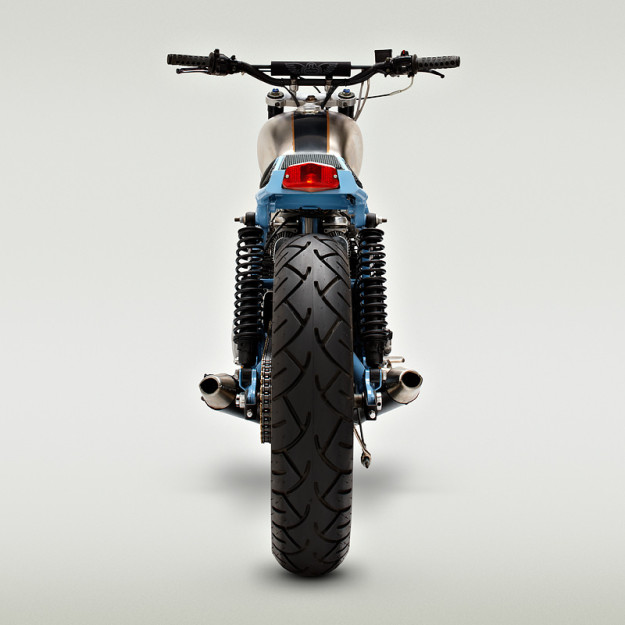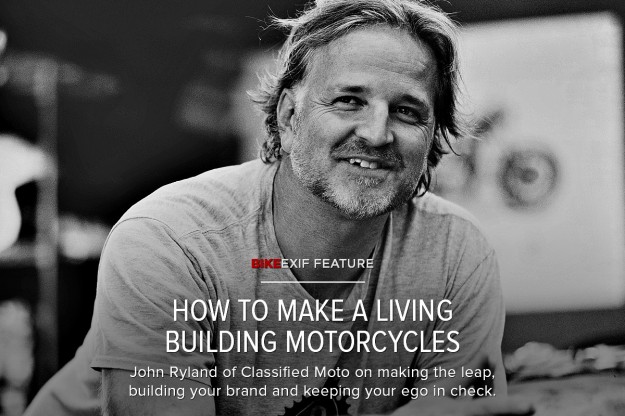
“Wouldn’t it be great to build motorcycles for a living?” I’m guessing the thought has crossed your mind while working on your own bike.
It’s kind of like saying, “Wouldn’t it be great to climb Mount Everest?” Of course it would, depending on your tolerance for discomfort—and even disaster.
In the few years that Classified Moto has been my livelihood, I’ve experienced highs and lows. I’ve felt pride, joy, fear and camaraderie. Plus the occasional overwhelming urge to punch someone square in the face.
Through it all, I’ve learned without a doubt that I’m an expert on nothing. Ironically this is probably the most valuable knowledge I’ve acquired. More on that later.
But: full disclosure here. Chris asked me to contribute this article, and I wasn’t going to turn him down. Maybe this becomes my first advice: If you get the chance to appear on Bike EXIF, take it.
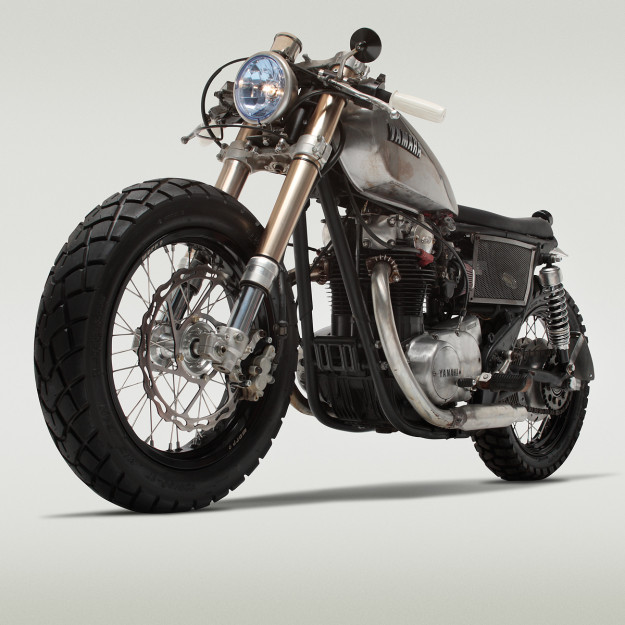
THE 3 ESSENTIAL TRAITS If you want a shot at building a successful motorcycle business, I believe you need three traits: Creativity, flexibility and enthusiasm. All three. And although we’re talking about bike building, these traits probably apply to any form of self-employment. (And life in general.)
Conventional wisdom says to run a successful custom bike company you need to be an amazing craftsman, a world-class welder, a master mechanic, and so on. I disagree.
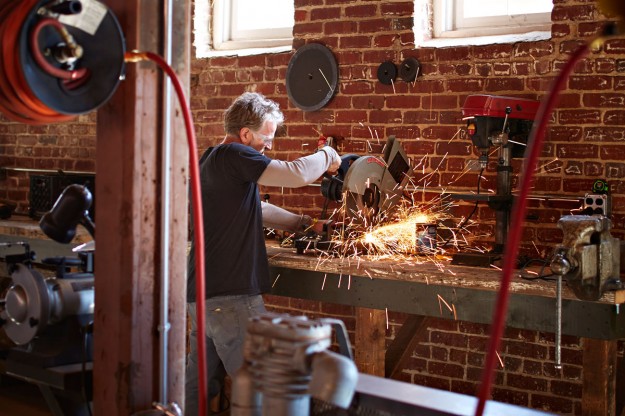
SKILLS v MAKING A LIVING Like it or not, the skills you need to build a motorcycle are not the same ones you need to make a living from building motorcycles.
Today, you need a vision—and the social graces to get good people on board, people who can help you execute that vision. I’ve found that clients who are drawn to Classified Moto bikes don’t care whether John Ryland did all the work, or whether he led a talented crew to get the job done.
It should be your goal to spend your time doing what you do best, and delegate the rest to specialists who do it better than you do.
If you are creative, flexible and enthusiastic, chances are you can round up a set of top-notch craftsmen to help get the builds done. And then other talented folks to help you convey what you’re doing to the public—by building your brand.
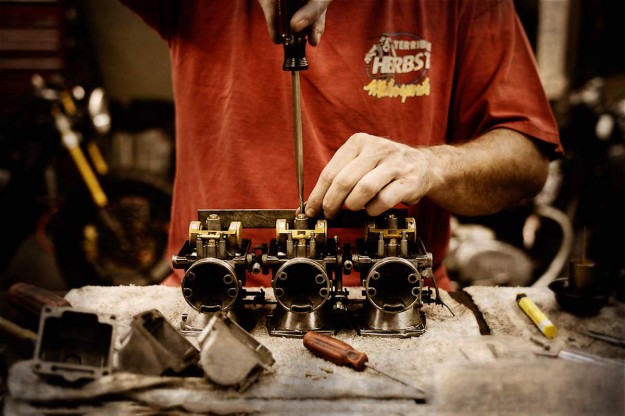
ARE YOU A POSER? There’s a bit of a notion afoot that building a brand for your business somehow makes you a poser. If you are going to build your own business one day, be careful before you join the bashing. You’ll be forced to eat crow. And you might also have to ask for advice from the successful ‘posers’ you mocked to begin with.
Yes, if you’re going to attempt to make a living at this, you’re going to have to market yourself in some way. And do it as well as (or better than) you can weld, sew, tune carbs or pull wheelies.
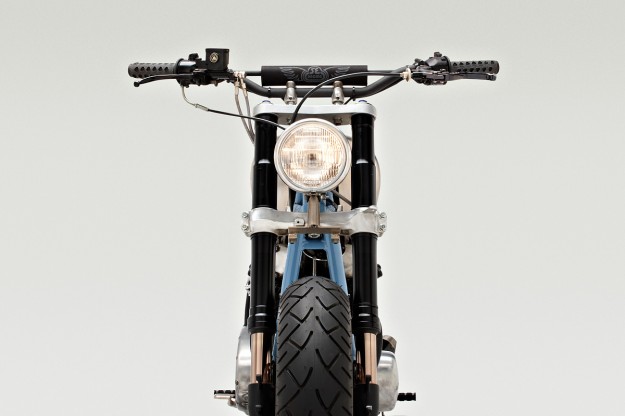
LOOK IN THE MIRROR Building a brand might seem easy, but it’s not just a logo design. It requires a lot of knowledge, and an instinctive feel for stuff you might not want anything to do with.
The most interesting thing? It forces you to see your work from the public’s perspective. You know how awesome you are, no doubt. But if you’re having a hard time convincing the masses of that fact—or even a few well-heeled clients—your bottom line will suffer.
WHAT SORT OF BUILDER PERSON ARE YOU? Start by figuring out what you bring to the table. Are you an order taker, a dictator, a trendsetter, a copycat, an asshole, or an unbridled artist?
Are your bikes easily recognizable? Are you filling a unique demand of some sort? People need a reason to get excited about what you’re trying to sell. So: Will they? Find something that you can be excited about as well, and make that the basis of your brand.
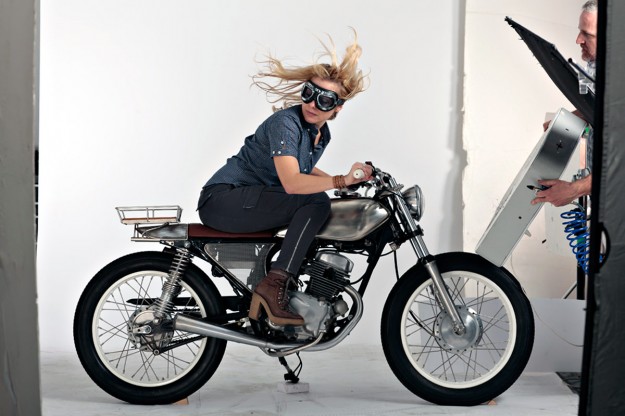
GET HELP Once you figure out your style, partner with people who can present you in the best light. Pay them, trade with them, but get them onboard somehow. In my case, I enlisted my good friend Adam Ewing to photograph all my bikes.
I met Adam when he shot some ads for BFGoodrich when I was working at an ad agency. I agreed to build him a bike and help him promote his own business. His images are one of the main reasons Bike EXIF and other big time media took notice of what I was doing.
Having a strong brand is the difference between staying in ‘hobby’ mode and turning what you love into a career. It’s what attracts customers, creates buzz and, yes, sells T-shirts.
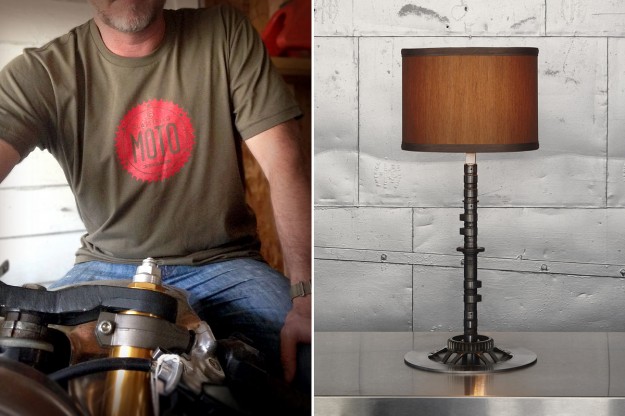
A WORD ABOUT ATTITUDE We’ve talked about the three traits you need to build a business: Creativity, flexibility and enthusiasm. It’s stuff you can adapt to. But there’s one thing that’s harder to influence—your attitude.
If attitude is not the single most important factor in your success, it’s pretty damn close. A handful of builders have achieved success despite what I’d consider to be a bad attitude—the nutshell version being, “I’m God’s gift to motorcycling. My skills are unmatched. Respect me, you idiots.” It’s annoying, repelling and clichéd, and more likely to hinder than help.
Claiming to be “the best” will add another layer of difficulty to your dream of owning a successful custom shop. And this business is difficult enough as it is.
I vote that you err on the side of humility. Admit what you know and don’t know. Know what you’re good at, and what you have no business doing. It will increase your chances of success. It will also make it hard for your detractors to claim you’re a fraud. They’ll still do it, but at least you’ve taken the high road.
This approach also makes it infinitely easier to ask questions and get answers. Plus it falls into the category of being a decent human being, which is nice. In summation, if you have a big ego, lose it.

DOLLARS AND SENSE Building a motorcycle for a customer is not the same as building one for yourself. Your personal projects are labors of love or obsession. (If you even keep track of your time invested, that’s weird and I don’t believe you.)
The parts you buy, the parts you break, the things you try that don’t work—on your own build, it’s all part of the hobby. Like you’d buy bait and tackle for your fishing habit. And you gladly accept those expenses as part of the experience.
When I started Classified Moto, it was not a moneymaking endeavor. To be honest, it was really just the name of a blog I started, chronicling the projects I was doing for my friends and myself.
I did the work for free and my friends would buy their own parts. Then I found myself shelling out more and more of my own money to finish the builds, because I didn’t feel like I could charge my friends for it.

I had no idea that would come to make profits so elusive. I soon realized how hard it is to estimate a custom project, and how important it is to keep track of what you’re spending. It’s the only way to know what to charge. And it’s probably the single most nerve-racking aspect of the job.
My advice? Charge what you need to charge to make it worthwhile. Duh, but it’s surprisingly easy to cheat yourself, because you’re afraid to say out loud what you really need to make.
So screen your customers politely. If price is their main concern, it should be noted. If you are in a position to subsidize their build, and deem it appropriate, by all means, go forth.
Otherwise, ignore the rantings of hobby builders and Blue-Book thumpers who think you charge too much. Ultimately, demand will determine what you can charge. If demand is low, rethink your product offering. But don’t price yourself out of a profit. You’ve gotta make a living after all.
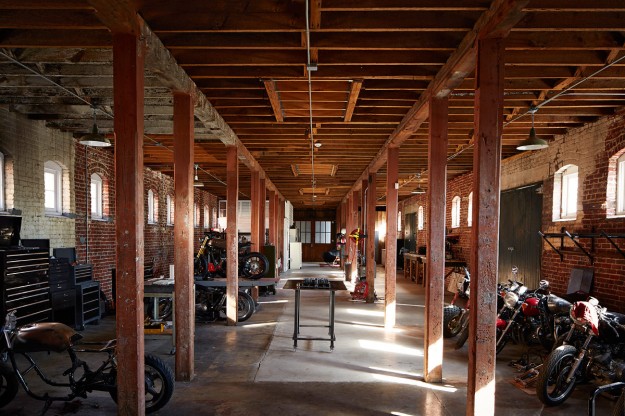
STICK TO THE DAY JOB Let’s assume you’re currently employed. That is great news! I believe it makes you much more likely to open your own custom bike shop than if you’re looking for a job.
In fact, if you’re unemployed and have dreams of opening a bike shop, your first step is to get a job. You will need a steady income, even if modest, to make this work.
I was still working 80+ hour weeks in advertising when I became obsessed with cobbling together bikes. I was starting to see my bank account looking healthy for a change, thanks to selling T-shirts and lamps made of old bike parts. It felt like success!
Then the hammer fell and I got laid off. I decided to take my severance and raid my 401K and step into the void of self-employment. It’s something I would never, in good conscience recommend, despite the way it has turned out.
What I will recommend is that you remain employed and enjoy the security it affords, while working every night and weekend to further your two-wheeled dreams.
This is the twenty teens and there’s no reason you can’t build a virtual presence for your brand without taking a dangerous plunge. Feel it out. Try to make some money while you’re still earning a salary. If it works out and things take off, then you can quit your day job. Maybe you can even buy the company one day, and fire your old boss.
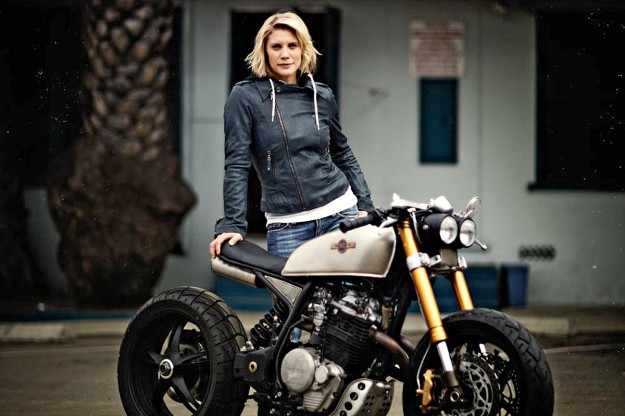
FINALLY: GO WITH YOUR GUT Once it can be trusted consistently, go with your gut feeling. Listen to advice from people who know more than you. Be vigilant with matters to do with money. Stick to the rules and goals you make for yourself. But be ready to throw it out the window at a moment’s notice. Flexibility, remember?
There will be times when your gut says Spend! and your brain says save, for example. Both are probably right. But if you make every decision based on conventional wisdom, you probably aren’t going to make anything mind-blowing.
My gut has told me to make a lamp for Jay Leno, to start my blog on a now-defunct software platform, to will an oil pump into working, and to cut a celebrity a deal on a build.
Most recently, it’s told me to take on a business partner, the great Alex Martin. He wanted to buy a bike but decided to invest in the company—not just financially, but in areas where I’m more than a bit deficient (like math and running a business, suckers!)
Despite the odd failure, I’ve learned to trust my inner voice of dissent when I hear it. And I’ve learned that not trusting it and getting burned is the worst. It sucks answering to yourself in those situations.
So. That’s all I’ve got. I hope it helps.
Actually, I could go on and on, but my gut says don’t tell everything you know.
Check out John Ryland’s builds on the Classified Moto website, or in the Bike EXIF Archives.
